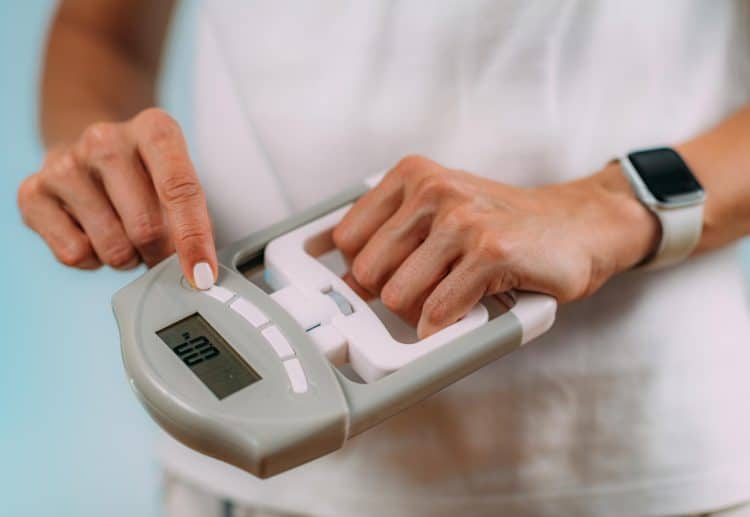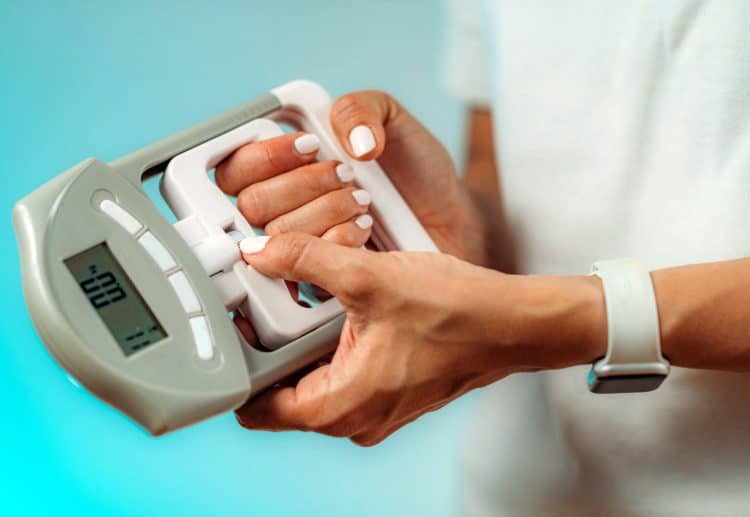As a 16-year gym veteran, I see the same trends repeating over and over again. Most lifters train their chest, back, shoulders, triceps, and biceps, but they forget the body part that enables all this — their hands (grip strength).
Most of my personal training clients fail a PR deadlift attempt not because of a poor form or posterior chain strength but due to a weak grip.
Conversely, most gym-goer could tell you their bench press or squat personal best, but only a few know their grip strength numbers.
Besides improving lifting performance, a strong grip serves as a reliable measure of your overall health and fitness. A study published in BioMed Central analyzed various factors like age, gender, residence, education level, and health status and found that lower grip strength was associated with an increased risk of stroke and heart disease. (1)
In this article, we delve into what grip strength is, average grip strength for men and women, different methods of measuring grip strength, factors affecting grip strength, and how to improve grip strength.
Average Grip Strength By Sex, Age, and Hand Dominance
Level Up Your Fitness: Join our 💪 strong community in Fitness Volt Newsletter. Get daily inspiration, expert-backed workouts, nutrition tips, the latest in strength sports, and the support you need to reach your goals. Subscribe for free!
The average grip strength can vary greatly depending on the gender, age, and hand dominance of an individual. Plus, the average grip strength is not linear for most people and increases and decreases throughout the years. The grip strength in right-hand dominant males tends to peak between the ages of 35 and 39, whereas it peaks in the 40 and 44 age bracket in women.
“Hand-Grip Strength: Normative Reference Values and Equations for Individuals 18 to 85 Years of Age Residing in the United States” is among the most detailed studies on the subject (2). Here are the findings of this research:
Average Grip Strength in Men
Per the research, the average grip strength rises marginally for men progressing from the 18 to 24 age group to the 25 and 29 brackets. However, they see a substantial drop as they enter the 30 to 34-year brackets. The average hand grip strength for men peaks in the 35 to 39-year brackets. It is 110.22 pounds in the dominant hand and 103.84 pounds in the non-dominant hand.
Men’s average grip strength dips to 64.9 pounds (dominant hand) and 60.06 pounds (non-dominant hand) in the 80 to 80-year age bracket.
| Age | Dominant Hand (pounds) | Non-Dominant Hand (pounds) |
| 18–24 | 105.16 | 97.9 |
| 25–29 | 108.46 | 103.84 |
| 30–34 | 101.42 | 99 |
| 35–39 | 110.22 | 103.84 |
| 40–44 | 100.98 | 93.94 |
| 45–49 | 89.54 | 88.88 |
| 50–54 | 98.56 | 97.46 |
| 55–59 | 85.14 | 81.84 |
| 60–64 | 88.66 | 81.62 |
| 65–69 | 80.52 | 82.5 |
| 70–74 | 79.86 | 75.9 |
| 75–79 | 73.7 | 66.44 |
| 80–85 | 64.9 | 60.06 |
Average Grip Strength in Women
The average grip strength for women by age group is lower than that for men of the same age group. The worst average grip strength was recorded in the dominant hand of females in the 75 to 79-year age group (40.04 pounds).
| Age | Dominant Hand (pounds) | Non-Dominant Hand (pounds) |
| 18-24 | 62.48 | 54.34 |
| 25–29 | 65.12 | 60.5 |
| 30–34 | 65.56 | 60.72 |
| 35–39 | 66.66 | 60.72 |
| 40–44 | 66.88 | 64.46 |
| 45–49 | 63.14 | 59.18 |
| 50–54 | 62.04 | 58.08 |
| 55–59 | 53.02 | 51.7 |
| 60–64 | 53.68 | 49.72 |
| 65–69 | 48.84 | 47.08 |
| 70–74 | 49.5 | 45.98 |
| 75–79 | 40.04 | 40.92 |
| 80–85 | 42.9 | 42.46 |
A 2011 Australian study also analyzed the average grip strength of males and females. However, instead of evaluating the dominant and non-dominant hands, it simply analyzed its subjects’ right and left-hand grip strengths. Here are the findings of the study: (3)
| Age | Male
left hand | right hand |
Female
left hand | right hand |
| 20–29 | 99 pounds | 103 pounds | 61 pounds | 66 pounds |
| 30–39 | 103 pounds | 103 pounds | 63 pounds | 68 pounds |
| 40–49 | 99 pounds | 103 pounds | 61 pounds | 63 pounds |
| 50–59 | 94 pounds | 99 pounds | 57 pounds | 61 pounds |
| 60–69 | 83 pounds | 88 pounds | 50 pounds | 52 pounds |
| 70+ | 70 pounds | 72 pounds | 41 pounds | 44 pounds |
Although the findings of this study vary from most other international literature, the vast data pool is an excellent benchmark to analyze your grip strength.
Remember, grip strength will vary for each individual depending on several factors. Use this data as a standard, and refrain from comparing yourself with others.
Measuring Your Grip Strength

Now that you know the average grip strength in males and females for different age groups, it’s time for you to assess how you stack up against your peers.
Some of the most popular grip strength tests are pinch strength, dead hang, plate pinch hold, farmer’s walk, rope climb, barbell hold, and finger strength tests. However, the results of these tests are not uniform and can vary depending on multiple factors. Here are the two most reliable methods to measure your grip strength:
- Hand Dynamometer
- Weight Scale
Hand Dynamometer
The hand dynamometer is the most popular tool to assess grip strength. It’s a hand-held device with a gauge that shows the amount of force you’re applying on the machine. Here is a step-by-step guide on how to use the hand dynamometer correctly:
Step One — Set the Dynamometer
Most hand dynamometers are adjustable. You must ensure that the device fits your hand perfectly. A device that is too big or small will give you an inaccurate reading.
Step Two — Warm-Up Your Hands
Hands comprise several bones, joints, tendons, and ligaments. Perform wrist rotations, finger extensions, and flexions to get the blood flowing in your hands. Feel free to perform light exercises like dead hangs and barbell holds to warm up your hands properly.
Pro Tip: The biggest rookie mistake I see people make is that they try to crush the dynamometer as soon as they get their hands on it. The hand dynamometer is like a workout for your hands. Warm up before you use this equipment.
Level Up Your Fitness: Join our 💪 strong community in Fitness Volt Newsletter. Get daily inspiration, expert-backed workouts, nutrition tips, the latest in strength sports, and the support you need to reach your goals. Subscribe for free!
Step Three — Sit Down
Avoid taking the hand dynamometer test while standing, as it can result in an incorrect reading. Sitting down on a sturdy surface eliminates your lower body engagement and will give you a more precise result.
Place your feet flat on the floor, and your arm should be at a right angle with your elbow by your side.
Step Four — Squeeze!
This is your time to shine. Squeeze the hand dynamometer as hard as you can. However, ensure that your arm remains at a right angle. Furthermore, avoid employing your lower body or any other cheeky method of generating more force. Limit yourself to your hand strength.
Step Five — Record the Score
After a certain threshold, the hand dynamometer will display your score in pounds or kilograms. Reset the meter and repeat the process a few times to get an average score for more accuracy. Repeat on the other side to get the measurement for both arms.
Weight Scale
Although using a weight scale to measure grip strength is somewhat unconventional, it is reliable and efficient. Since most people have a weight scale at home, it is one of the most accessible ways to measure your grip strength. Here is how to do it:
Step One — Set up the Scale
You’ll hold the scale in front of your hips, so ensure the needle is at zero in this position.
Step Two — Take Your Grip
Place the heels of both hands on the top of the scale on the edges and your fingers wrapped around to the bottom. The weighing scale should be parallel to the floor throughout the test.
Step Three — Squeeze
Squeeze the weighing scale as hard as you can. Record the reading when the needle stops at a particular point.
Remember, the weighing scale method is less accurate than using a hand dynamometer. Weighing scales are generally designed to measure static weight, not dynamic force, so the readings might not precisely reflect your true grip strength.
Professional athletes should use a hand dynamometer to record their hand strength, as it gives a more objective assessment of how it affects their overall performance.
If your grip strength is weaker than the average for your age and gender, you must avoid the urge to do too much too soon. Gradually incorporate grip strength exercises into your training regimen so your muscles have enough time to adapt and reduce the risk of injuries.
Grip Strength and its Health Implications
Contrary to what most people think, grip strength extends beyond hand strength, as it also includes forearm muscular ability. Hand and forearm strength and functionality are vital in health, fitness, and sports performance. Grip strength can also be a predictor of long-term health outcomes.
The study “Handgrip Strength and Health in Aging Adults” discussed how handgrip strength (HGS) is often used to indicate overall muscle strength in aging adults and is associated with various poor health outcomes like chronic morbidities, functional disabilities, and all-cause mortality. (4)
You learn the importance of a strong grip the very first time your gym trainer asks you to perform a deadlift. You are as strong as your grip strength in pulling exercises like deadlifts, bent-over barbell rows, lat pulldowns, and pull-ups.
Besides weight training, a solid grip strength can improve your performance in activities like snow shoveling, rock climbing, carrying grocery bags, lifting kids, playing baseball, cricket, tennis, or golf.
The average grip strength varies depending on factors like age, sex, and lifestyle. Men, on average, have a stronger grip than women because of the physiological differences. Furthermore, grip strength peaks in young adulthood and gradually declines with age.
Understanding these differences is crucial for athletes, trainers, and healthcare professionals to set realistic, personalized goals and assess health risks.
Factors Affecting Grip Strength
Grip strength can vary for each individual depending on a myriad of factors, including:
- Genetics: Genetics dictate the baseline strength and potential for muscle development, including muscles involved in grip. Some folks are genetically predisposed to stronger grips than others.
- Lifestyle: Daily habits and occupation can significantly affect grip strength. For example, jobs or hobbies that involve manual labor or repetitive hand movements can result in a stronger grip.
- Environmental Factors: Access to training equipment and facilities can lead to stronger grip strength. Plus, people who must shovel snow tend to develop a robust grip.
- Nutrition: Eating a balanced diet leads to strength and muscle development, which can improve grip strength. (5)
- Training: Regular exercise, particularly targeted strength training, is excellent for developing and maintaining grip strength. Compound exercises like deadlifts, pull-ups, and farmer walks should be a constant in your training regimen for a solid grip.
Improving Grip Strength: Techniques and Exercises
Building a stronger grip can improve your sports performance and functionality and boost your overall health. Here are a few exercises and techniques to build a robust grip:
Exercises for Grip Strength:
Sports to Improve Grip Strength:
- Weight Training
- Rock Climbing
- Gymnastics
Staying consistent with your training is one of the most crucial aspects of building a stronger grip. Plus, adding variety and employing progressive overload in your workouts will help you achieve your training objectives faster.
Conclusion
Grip strength is one of the most overlooked aspects of strength training. It can also be used as a reliable health indicator to ensure optimal functionality. Use the average grip strength benchmarks provided in this article to design your training program and achieve your fitness objectives.
If you have any questions about grip strength or how to access or improve it, drop them in the comments below, and I’ll be happy to help!
References
- Li G, Lu Y, Shao L, Wu L, Qiao Y, Ding Y, Ke C. Handgrip strength is associated with risks of new-onset stroke and heart disease: results from 3 prospective cohorts. BMC Geriatr. 2023 May 4;23(1):268. doi: 10.1186/s12877-023-03953-8. PMID: 37142986; PMCID: PMC10161641.
- Wang YC, Bohannon RW, Li X, Sindhu B, Kapellusch J. Hand-Grip Strength: Normative Reference Values and Equations for Individuals 18 to 85 Years of Age Residing in the United States. J Orthop Sports Phys Ther. 2018 Sep;48(9):685-693. doi: 10.2519/jospt.2018.7851. Epub 2018 May 23. PMID: 29792107.
- Massy-Westropp NM, Gill TK, Taylor AW, Bohannon RW, Hill CL. Hand Grip Strength: age and gender stratified normative data in a population-based study. BMC Res Notes. 2011;4:127. Published 2011 Apr 14. doi:10.1186/1756-0500-4-127
- McGrath RP, Kraemer WJ, Snih SA, Peterson MD. Handgrip Strength and Health in Aging Adults. Sports Med. 2018 Sep;48(9):1993-2000. doi: 10.1007/s40279-018-0952-y. PMID: 29943230.
- Carbone JW, Pasiakos SM. Dietary Protein and Muscle Mass: Translating Science to Application and Health Benefits. Nutrients. 2019;11(5):1136. Published 2019 May 22. doi:10.3390/nu11051136










